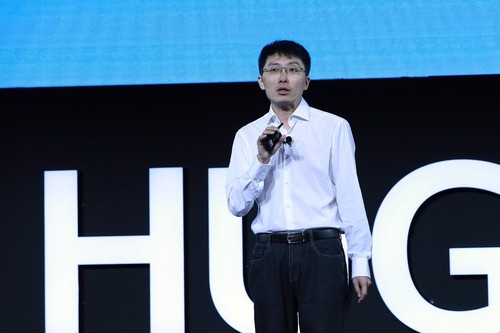June 25, 2019

At the Huawei User Group Meeting 2019, Tang Hong, director of the Data Communication Research Institute, Intelligent Network & Devices Research Institute at China Telecom, delivered a keynote speech entitled "Intelligent Transport Networks in the 5G and Cloud Era."
In his insightful speech, Tang highlighted the unprecedented transport network challenges arising from the rapid development of emerging services, including 5G, cloud VR/AR and site-to-cloud private lines for enterprises. Specifically, transport networks shall provide larger capacity and higher interface bandwidths to meet the predicted tenfold traffic growth in the next five years. Transport networks should also provide more flexible and elastic connectivity needed for 1000-fold increase in connections due to Internet of Things (IoT) communication and trillions of apps, ever-increasingly meshed traffic and uncertain service connections. Driven by one-click-to-cloud and inter-domain connections, network-wide automation and proactive O&M will be must-haves for transport networks as well.
With the advent of the 5G and cloud era, the network has become the digital foundation for 5G infrastructures. Typical network trends include providing ultra-high bandwidth and application-level Service-Level Agreements (SLAs) to serve the access of massive vertical industries; adding intelligence to networks; and comprehensively transporting diverse services.
To keep up with these inevitable trends, intelligent transport networks are emerging for the 5G and cloud era and taking on three distinct characteristics: ultra-broadband network, intelligent connections and committable high availability. Specifically, "ultra-broadband" redefines cost-effective network infrastructures by making the most of 50 Gigabit Ethernet (GE), 100GE and 400GE interfaces. "Intelligence" reshapes connections with SRv6 for flexible and reliable connections. "Simplicity" reinvents operations and maintenance (O&M) by introducing a Software-Define Networking (SDN)-capable intelligent management and control system for simplified O&M and improved network availability.
Ultra-broadband network: leveraging the mature industry chain to build a cost-effective ultra-broadband network
In the 4G era, GE rings were used at the access layer of a transport network during the early stages. With the rapid traffic growth, GE rings evolved to 10GE rings. When it comes to the 5G era, the access ring bandwidth will exceed 10 Gbit/s. Currently, the mainstream interfaces beyond 10GE are the extremely costly 100GE interfaces. As such, an alternative is 50GE, an innovative Ethernet interface technology, which will be the best choice for operators to meet the access ring bandwidth requirements. This is because 50GE can use the same optical-layer industry chain as that used by 25GE, as 25GE optical modules are in wide commercial use in data centers (DCs).
The combined use of single-channel 25GE optical components and PAM4 achieves high-speed 50GE transmission. In this regard, the concerted efforts made by upstream and downstream players in the industry chain will help operators reduce the network construction costs. In addition, PAM4 technology can also be used on 400GE optical modules and will eventually help operators build end-to-end, cost-effective and high-bandwidth networks.
Intelligent connections: using SRv6 to cope with uncertainties of service connections
Nowadays, traffic overflow brought about by cloud computing is becoming more apparent than ever. However, traffic is often distributed throughout the network and the demands for east-west connections keep increasing. This requires flexible and elastic connectivity on the network, and SRv6 well meets this pursuit. SRv6 is a combination of segment routing (SR) and IPv6. The number of IPv6 addresses is huge, meeting the massive application and service access requirements. The SRv6-based Nature IP attribute and powerful programmability help with automatic inter-domain connections and allow one-click-to-cloud for service configurations. SRv6 can also provide service awareness and SLA guarantee at the tenant and app levels.
In January 2019, the Intelligent Network & Devices Research Institute of China Telecom joined forces with Huawei to complete the verification of the first SRv6 commercial-use in China. In February 2019, China Telecom partnered with Huawei to implement the first global commercial use of SRv6, reducing the inter-domain service provisioning time from months to days.
Committable high availability: using SDN technology to simplify O&M and improve network availability
As a multi-service transmission pipe, the transport network has native characteristics like a large number of nodes, complex configurations, inability to detect terminal service quality and difficulty in self-evidence. These factors have brought great challenges to network O&M in the 5G era.
Additionally, traditional O&M for operators' networks is driven by user complaints. The NMS is highly dependent on device alarms and cannot diagnose or predict potential faults. In addition, the O&M of routers is difficult and error-prone as well as heavily relies on personnel skills.
Against this backdrop, how to implement proactive O&M and improve O&M efficiency with the focus on user experience is in urgent need. The SDN-capable intelligent management and control system can make a difference. This new O&M system features intelligent connections and high availability, achieving automated O&M for the entire lifecycle of IP transport networks.
A combination of the SDN controller and SRv6 helps implement 50 ms protection switching for any topology, traffic optimization and fast fault location to achieve network-wide load balancing and predictive maintenance, thereby improving network availability. These benefits help China Telecom with business expansion in vertical industries in the 5G and cloud era.
4G changes people's lives, while 5G changes society. Tang said that 5G transport networks not only support people-people connections, but also enable rapid development across vertical industries, such as intelligent manufacturing, intelligent transportation (autonomous driving), smart city and intelligent health. In the future, China Telecom will continue to carry forward their openness philosophy and work with industry partners to build 5G transport capabilities and enable 5G services for new win-win outcomes in the future.
This blog is sponsored by China Telecom.
You May Also Like










